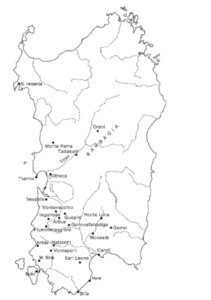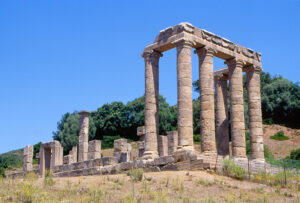The presence of Near Eastern merchants in the mining basins of north-western Sardinia is documented as early as the 8th-7th centuries BC, as evidenced, among other things, by the discovery in the village of S. Imbenia (Alghero), in the so-called “hut of the deposits”, Punic amphorae (Bartoloni B2 type) with copper ingots and, in the area of Iglesias, the discovery in Monastir of a lead bread with the letter zayin associated with archaic pottery from the 8th-7th centuries BC. In the Punic period, the mining interest seems to have been particularly focused on the Iglesiente basin, with Antas and Sulcis being strategic points of reference for the supply of metal for local use, as evidenced, among other things, by the traces of a workshop with an accumulation of iron slag and the remains of furnaces identified in a room of the acropolis of Monte Sirai dating from the 5th-3rd centuries BC. Strands of cassiterite have been found on Monte Linas, near Villacidro, and traces of the mineral have been found in the sands of the Cedrino river. Cassiterite deposits have also been found in the area of Nora, where they were exploited during the Iron Age. The use of
The use of the copper, iron and lead veins in this area seems to have been determined by the difficulty of reaching the Iglesiente and to have been exclusively for local needs, as shown by the study of the metal slag found in Nora in the area of the Macellum, dating from the 3rd to 2nd centuries B.C., and on the north-western slopes of the Tanit hill, dating from the 2nd to 1st centuries B.C. The same possible origin has also been hypothesised for the weapons found in the tombs of Bitia. Similarly interesting are the data from the site of Santu Teru, which includes the necropolis of Monte Luna, probably a military settlement from the 5th century BC. The considerable quantity of metal slag found on the southern side of the Santu Teru hill has led to
the hypothesis of the existence of ore processing areas, probably coming from Gerrei and Barbagia and destined, together with agricultural products from Trexenta, for the Caralis area. Evidence of exploitation can also be found in the Monte Ferru area, where outcrops of hematite and limonite iron oxides and sulphides of iron (pyrite) and iron and copper (chalcopyrite) have been identified.
The region seems to lie along one of the main lines of penetration to the north-east of the island, where silver mines were located. Monetary finds along the Tirso valley as far as Tadasuni and archaeological evidence to the south of the Margine chain and the Ottana plain suggest that, even in Punic times, two different routes were used to reach the mining basins, which converge at Orani, near which stands the Nuragic temple of Nurdole, where the presence of a smelting workshop has also been hypothesised. Traces of Neolithic, Nuragic, Punic and Roman sites have been identified in the lead-zinc mining basin of Montevecchio, where Roman mine
shafts have been identified and objects related to the extraction and initial processing of the ore have been found. Large quantities of litharge and lead slag from the Punic-Roman period have been found at Bocche di Sciria, documenting pyrometallurgical activity for the extraction of silver by the cupping process.
Mining pits have been identified at Sa Frangia and ancient foundries have been hypothesised at Sa Matta and Genna Abis. From the studies carried out it seems plausible to hypothesise a mining activity mainly concentrated along the galena and blende filonian system of Montevecchio-Ingurtosu-Gennamaria, while the first refining and preparation of the metal must have taken place on the eastern side, towards Arbus and Guspini, along the Neapolis-Metalla road. The point of arrival of the metal from the mining region seems to have been Neapolis and Tharros. Already in 1981 it was speculated that the Punic centres of Othoca and Neapolis may have been sub-colonies of Tharros with different roles: Neapolis would have been the arrival point for metal from the Montevecchio mining basin; Othoca, more devoted to agricultural production, would have been a storage centre for agricultural products from the hinterland.


